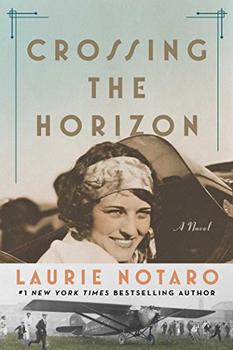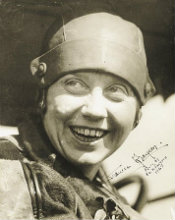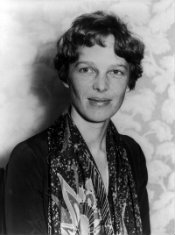Summary | Excerpt | Reading Guide | Reviews | Beyond the Book | Read-Alikes | Genres & Themes | Author Bio

Critics' Opinion:
Readers' Opinion:
First Published:
Oct 2016, 464 pages
Paperback:
Jun 2017, 464 pages
 Book Reviewed by:
Book Reviewed by:
Kim Kovacs
Buy This Book
This article relates to Crossing the Horizon
In Crossing the Horizon, author Laurie Notaro highlights the lives of three women who dared to attempt flight across the Atlantic Ocean during the early days of air travel. They were not the only ones who defied expectation by taking such risks. The novel mentions three other women who also took on the daunting challenge of transatlantic flight:
Princess Anne of Lowenstein-Wertheim-Freudenberg (1864-1927) was born in London, the youngest daughter of John Savile, 4th Earl of Mexborough. At 33, she married Prince Ludwig of Lowenstein-Wertheim-Freudenberg (a province of the German Empire) in a lavish ceremony. Her husband disappeared from London mysteriously less than a year after they were wed, and only later did she learn he was killed in the Philippines during the Spanish-American War, where he was strongly suspected of being a German spy. Anne returned to England but refused to abandon the title of Princess of Lowenstein-Wertheim-Freudenberg in spite of anti-German sentiments in Great Britain during WWI (at one point Anne was accused of being a German spy herself because of her ties by marriage to that country). She began flying in 1914; an urgent need to reach Paris quickly prompted her to engage a pilot to ferry her from England, and she was hooked on air travel from then on.
She met famous WWI flying Ace Leslie Hamilton in 1922 and the two became fast friends, leading her to sponsor his flight—and ride as a passenger—during the 1923 King's Cup air race. When Hamilton decided to attempt flight across the Atlantic from England to Canada—something no one else had achieved—Anne sponsored this journey as well. She purchased a Fokker F. VII monoplane, christened it The Saint Raphael, and recruited a co-pilot. It's unclear if she decided to join the flight at the last minute or if that was her plan all along, but on August 31, 1927 at 7:32 a.m., the three departed from Upavon, Wiltshire for Canada (Anne, at 63, in purple leather knee-breeches with matching jacket and high-heeled boots, and strapped into a wicker chair in the back of the cockpit). The plane was spotted at 9:44 p.m. that night by an American tanker about 800 miles west of Galway, Ireland, in a strong headwind, and it was apparent that they hadn't gotten as far as was expected. The Saint Raphael was not seen again, and it was assumed that the three died at sea. One of the plane's wheels washed ashore a year later, but no other trace was found.
 Frances Wilson Grayson (1892-1927) was the niece of President Woodrow Wilson. Born in Arkansas, she had a varied career, pursuing music and dramatic arts before settling in New York City, where she wrote for a newspaper and later became a real estate agent. She became enamored with flying while living in New York, becoming obsessed by the idea of crossing the Atlantic after reading about Charles Lindbergh's historic flight in May 1927. She received financial backing from a close friend, the daughter of a Pittsburgh steel magnate, and commissioned a float plane from one of the era's leading engineers, Igor Sikorsky. He designed an S-36 for her, named Dawn. Grayson hired Wilmer Stultz to pilot the craft, planning from the start, to share piloting duties with him. She also brought navigator Brice Goldsborough and radio engineer Frank Koehler on board.
Frances Wilson Grayson (1892-1927) was the niece of President Woodrow Wilson. Born in Arkansas, she had a varied career, pursuing music and dramatic arts before settling in New York City, where she wrote for a newspaper and later became a real estate agent. She became enamored with flying while living in New York, becoming obsessed by the idea of crossing the Atlantic after reading about Charles Lindbergh's historic flight in May 1927. She received financial backing from a close friend, the daughter of a Pittsburgh steel magnate, and commissioned a float plane from one of the era's leading engineers, Igor Sikorsky. He designed an S-36 for her, named Dawn. Grayson hired Wilmer Stultz to pilot the craft, planning from the start, to share piloting duties with him. She also brought navigator Brice Goldsborough and radio engineer Frank Koehler on board.
The plane proved to be exceptionally heavy, requiring multiple take-off attempts to get off the ground during test flights and doing poorly in bad weather. Stultz eventually refused to undertake the crossing, feeling that to do so in that aircraft in winter would be suicidal. Frances replaced him with Royal Norwegian Navy Lieutenant Oskar Omdal, and the four took off from Long Island on December 23, 1927 at 5:07 p.m. bound for Newfoundland, from where they planned to officially start their journey to London. The plane never made it to Newfoundland; later that evening those aboard a British schooner thought they heard a motor and then a large splash off Nauset Beach. Although searches began almost immediately, the four aviators were never found. In January 1929, however, a young boy in Massachusetts found a bottle with a note in it that read, "1928. We are freezing. Gas leaked and we are drifting off Grand Banks. Grayson." The message's authenticity was never verified.
 Amelia Earhart (1897-1937) is the most famous of the women mentioned in Crossing the Horizon. Born in Atchison, Kansas, to an upper-middle class family, she developed her love of flying after taking a 10-minute flight at an airshow in Long Beach, CA. She decided to become a pilot and worked a variety of jobs to save money for lessons. She purchased a used, bright yellow biplane in the summer of 1921, and in 1922 set her first record when she flew The Canary to 14,000 feet – the altitude record for female pilots. On May 15, 1923 she became the 16th woman to be issued a pilot's license by the world governing body for aeronautics. Although Earhart had financial setbacks that eventually forced her to sell her plane, she went on to establish many subsequent flying records with backing from influential investors such as publisher George Putnam.
Amelia Earhart (1897-1937) is the most famous of the women mentioned in Crossing the Horizon. Born in Atchison, Kansas, to an upper-middle class family, she developed her love of flying after taking a 10-minute flight at an airshow in Long Beach, CA. She decided to become a pilot and worked a variety of jobs to save money for lessons. She purchased a used, bright yellow biplane in the summer of 1921, and in 1922 set her first record when she flew The Canary to 14,000 feet – the altitude record for female pilots. On May 15, 1923 she became the 16th woman to be issued a pilot's license by the world governing body for aeronautics. Although Earhart had financial setbacks that eventually forced her to sell her plane, she went on to establish many subsequent flying records with backing from influential investors such as publisher George Putnam.
She departed from Newfoundland as a passenger in a Fokker F.VIIb/3m dubbed Friendship, which was piloted by Wilmer Stultz (who had refused to fly with Frances Wilson Grayson the year before) and co-pilot/mechanic Louis E. Gordon. After a flight of 20 hours, 40 minutes, they touched down in Wales thereby becoming the first woman to successfully fly across the Atlantic. In May 1932, she became the first woman to do so solo, a feat which won her wide acclaim as well as the Distinguished Flying Cross from the U.S. Congress. Earhart disappeared over the Pacific in March 1937 during an attempt to circumnavigate the globe at its equator.
These were but a few of the brave aviatrixes who paved the way for others. More such astonishing women can be found at mashable.com.
Picture of Frances Wilson Grayson from Wikipedia.org
Picture of Amelia Earhart from Library of Congress
Filed under People, Eras & Events
![]() This "beyond the book article" relates to Crossing the Horizon. It originally ran in October 2016 and has been updated for the
June 2017 paperback edition.
Go to magazine.
This "beyond the book article" relates to Crossing the Horizon. It originally ran in October 2016 and has been updated for the
June 2017 paperback edition.
Go to magazine.





The House on Biscayne Bay
by Chanel Cleeton
As death stalks a gothic mansion in Miami, the lives of two women intertwine as the past and present collide.

The Flower Sisters
by Michelle Collins Anderson
From the new Fannie Flagg of the Ozarks, a richly-woven story of family, forgiveness, and reinvention.

The Funeral Cryer by Wenyan Lu
Debut novelist Wenyan Lu brings us this witty yet profound story about one woman's midlife reawakening in contemporary rural China.
Your guide toexceptional books
BookBrowse seeks out and recommends the best in contemporary fiction and nonfiction—books that not only engage and entertain but also deepen our understanding of ourselves and the world around us.